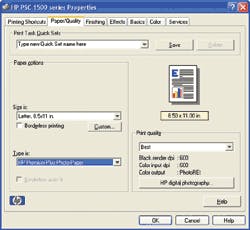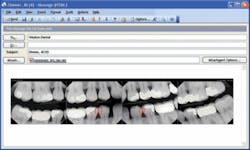When You Care Enough To Send the Very Best
by Jeffrey B. Dalin, DDS, FACD, FAGD, FICD
We’re all familiar with the Hallmark slogan. Although it refers to greeting cards, it rings true for the digital images we print and send to our patients and colleagues. Since my last article on this topic, I’ve seen better overall quality of printouts, but there’s still some room for improvement. Considering these images are used for diagnosis and treatment, the level of care given to the printing process should equal the care given to the initial capture of the digital image.
While I feel there’s simply no reason for a dentist to continue to use film, I do contend that when a film user receives an inferior digital image printout, it gives the doctor an excuse to stay with film. He or she erroneously thinks that the actual images are not diagnostic. So, for those of you who are sending less than stellar printouts, you are holding your colleagues back from experiencing the benefits you gain each day by being a digital dentist. If your images are highly diagnostic on your monitors but not on paper, there’s simply a flaw in the process. Let’s take a look at some of the basic information about printing and see what changes can improve the end result.
The printed image
There are three main factors that determine the quality of printed images:
- The printer
- The paper
- The knowledge and execution of the person who prints
The printer
Inkjets are the most commonly used printer type for image printing. They use microscopically small droplets of ink to form letters and graphics. Most inkjet printers use two cartridges to supply these droplets: one with black ink and one with colored ink (cyan, magenta, and yellow).
Compare these to laser printers that work much like a plain-paper copier, forming images by transferring toner onto paper passing over an electrically charged drum. This process can give you sharp black and white text (no color or subtle shades of gray), but printed images are generally not of diagnostic quality. To attain this quality, I strongly recommend that you use only a high-quality inkjet printer. Save your laser printer for your front desk’s office management printing.
Printers differ in the fineness of detail they can produce. The main measure of print quality and sharpness of images is known as resolution, which is expressed in dots per inch (dpi) - the larger the dpi, the sharper the image. As a general guide in selecting an inkjet printer, I encourage you to consider the better quality models from Hewlett-Packard, Canon, or Epson. Currently, prices for these quality inkjet printers start below $100. It’s also a good idea to check with your digital image company for recommendations.
The paper
Choosing a good quality paper is crucial to reproducing the highest quality final image. Photocopier paper just isn’t going to cut it. This is true for digital radiography as well as digital photography. There is a good reason why images printed on ordinary paper come out blurry and washed out. Ink tends to “bleed” into the rough surfaces of ordinary paper. High-quality inkjet paper or photo paper is coated with a glossy or matte finish that “holds” the ink in place, creating greater image detail. Choosing an inkjet paper that is bright white (99 percent and above) makes the images look even better. Any major brand offers fine quality paper suitable for this purpose. Personally, I prefer to use photo paper. If you shop around, you can find large quantities at reasonable prices.
The technique
Even if you’ve been printing digital images for some time, I urge you to critically evaluate your printouts. Perhaps your new team member who handles this task doesn’t understand how important printouts really are. Or perhaps staff members are not verifying that they are selecting the right printer, paper, and settings when printing. Start with the selections I’ve presented here. And don’t hesitate to ask tech support for assistance if you believe your printout can be improved.
Logistics
To simplify things, I have a good quality printer set up on my network exclusively to print all of my digital images. It is preset to photo paper, and at the printer’s highest quality setting.
By having a dedicated printer, preloaded with photo paper and configured to the best settings, we do not have to constantly readjust our printer for each printout. I also have a copy of a high-quality image printout posted above this printer. My team knows to check with me if their new printout does not share the same quality.
Alternatives to printed images
There are ways to avoid print issues altogether. Images can be burned on a CD and sent to dentists and patients. And don’t forget that with more and more dentists having e-mail access, you can e-mail images. Even a nondigital doctor can view these images on any computer.
My digital imaging software allows me to burn and to e-mail images directly from the program. Recipients need only to open the images with their standard picture viewer or import them into their own digital dental software.
Whether print or e-transfer, the images that you send to other dentists or out the door with your patients are a reflection of the quality of work that you perform. With good equipment choices and attention to detail, your digital radiographic and photographic images will be crisp and clear, and something that you can share with pride.
Jeffrey B. Dalin, DDS, FACD, FAGD, FICD, practices general dentistry in St. Louis. He is the editor of St. Louis Dentistry magazine, and spokesman and critical-issue-response-team chairman for the Greater St. Louis Dental Society. He is a co-founder of the Give Kids A Smile program. Contact him at [email protected].


